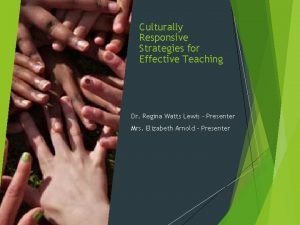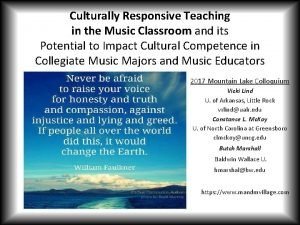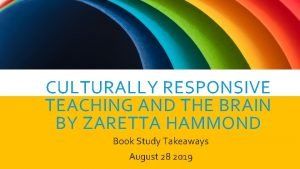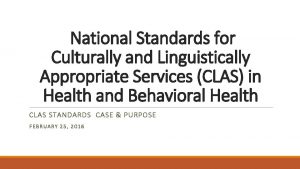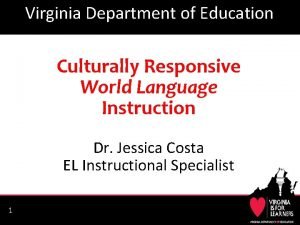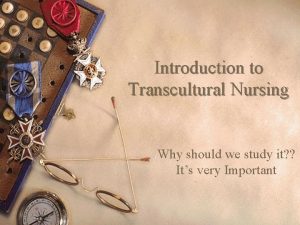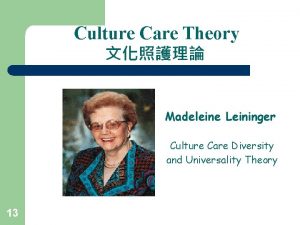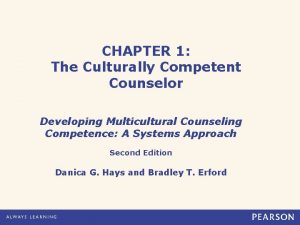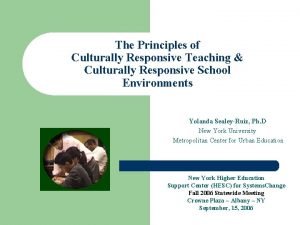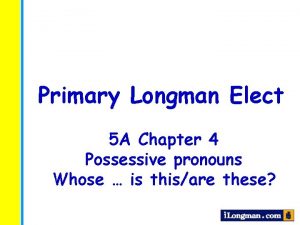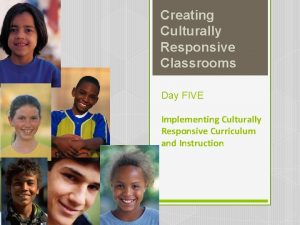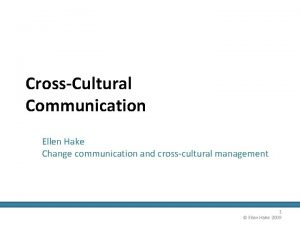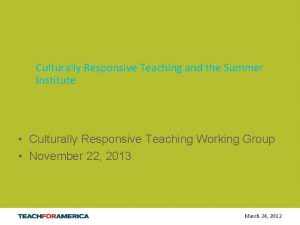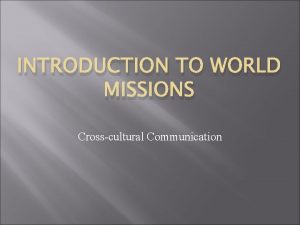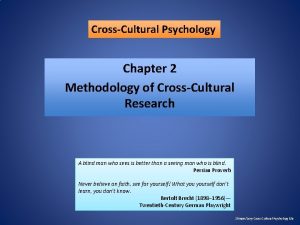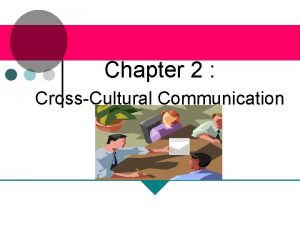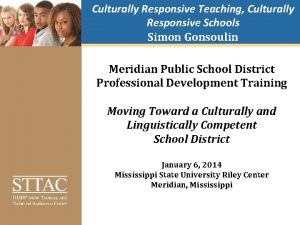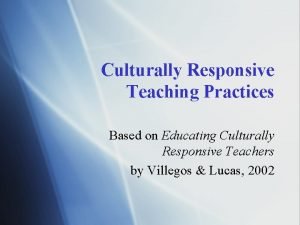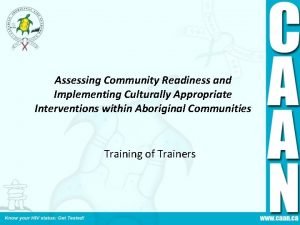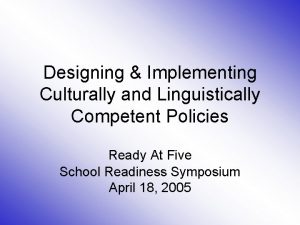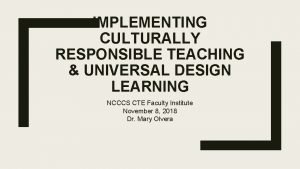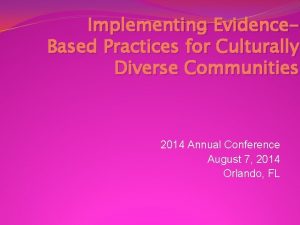Culturally Yours Developing and Implementing CrossCultural Education in























- Slides: 23


Culturally Yours Developing and Implementing Cross-Cultural Education in Foreign Language Teaching Sevgi Can & Ayça Palancılar Koç University English Language Center İstanbul, Turkey SLTEP Alumni Conference November 1, 2014 SABANCI UNIVERSITY

Is language use associated with cultural behaviour? § One afternoon after work, a British teacher of EFL, who had recently started teaching at a college in Hong Kong, decided to visit some friends who lived in a different part of the city. She went to the appropriate bus stop, and as she walked up, a group of her students who were waiting there asked “Where are you going? ” Immediately she felt irritated, and thought to herself, “What business is it of theirs where I’m going? Why should I tell them about my personal life? ” However, she tried to hide her irritation, and simply answered, “I’m going to visit some friends. ”

Several months later, this British teacher discovered that “Where are you going? ” is simply a greeting in Chinese. There is no expectation that it should be answered explicitly: a vague response such as “Over there” or “Into town” is perfectly adequate. Moreover, according to Chinese conventions, the students were being friendly and polite in giving such a greeting, not intrusive and disrespectful as the British teacher interpreted them to be.

How can educators raise cultural awareness and help learners produce cultural identity in foreign language teaching ?

Today’s Outline §How is culture defined? §What constitutes cultural values? §What is included in cultural behavior? §Why should we consider teaching of cultural skills? §Classroom Applications

How Culture is Defined? § Culture is defined as… ‘as an integrated pattern of human behavior that includes thoughts, communications, languages, practices, beliefs, values, customs, courtesies, rituals, manners of interaction and roles, relationships and expected behaviors of a racial, ethnic, religious or social group, and the ability to transmit the above to succeeding generations’ (The National Center for Cultural Competence of Georgetown University)

Culture § “third culture” § fifth skill § The “Big C” and “Little C”

I. Cultural Knowledge § language and thought, • “dress of thought” § “non-verbal thought” § Thought is completely determined by language.

II. Cultural Values § the ‘psyche’ of the country

How can we teach cultural values?

What can be used to introduce culture in the language classroom? § Art work § Commercials § Videos/movies (made in the original country) § Music videos § News casts § Pod casts § Radio § Field trips § § § § § Festivals Maps Songs Newspapers Anecdotes Illustrations Photographs Literature Stories Authentic materials (Materials used by native speakers)

III. Cultural behavior § “Not only is the transmission of knowledge and language important, but also are the nuances of values and attitudes. ” (Corner & Bunt-Kokhuis, 1991)

IV. Cultural skills +

§ “Attention to cultural details doubles the usefulness of the lesson, not only in adding another dimension, but also in making the lesson more interesting and therefore easier to learn. ” (Harrison, 1990)

Classroom Application § Communicative Language Teaching § Community Language Learning

Activity 1: Gestures Aims: § recognizing the meaning of specific gestures in one’s own culture § identifying with the meaning of gestures in American culture § differentiating the meaning of gestures between US culture and other cultures

Activity 2: Thanksgiving

Activity 2: Thanksgiving Aims: § discussing traditional celebrations in one’s own culture § recognizing the significance of Thanksgiving (Friends segment) § raising awareness of traditional celebrations in US culture

Key Ideas to Remember § thoughts and behaviour are determined by language § third culture, fifth skill, the Big C § the ultimate goal: to communicate and to be able to use language correctly and appropriately § achieving a balance and exchange between cultural and educational experiences

Q & A Questions?

Bibliography § § § § Abrams, M. H. 1953. The Mirror and the Lamp: Romantic Theory and the Critical Tradition. Oxford: Oxford University Press. Bruner, J. S. Goodnow & G. A. Austin (1956] 1962. A Study of Thinking. New York: Wiley. Corner, T. & Bunt-Kokhuis, S. 1991. The Space between words: Cross-cultural Essays in Education. Tilburg, Tilburg University Press. Fish, S. 1980. Is There a Text in This Class? The Authority of Interpretative Communities. Cambridge, MA: Harvard University Press. Freeman, D. & Freeman, Y. 2004. Essential Linguistics: What You Need to Know to Teach Reading, ESL, Spelling, Phonics, and Grammar. Portsmouth, NH: Heinemann. Giroux, H, & Mc. Laren, P. 1994. Between Borders: Pedagogy and the Politics of Cultural Studies. New York; London: Routledge. Goode, Sockalingam, Brown, & Jones, 2000. National Standards in Foreign Language Education Project. 1996. Standards foreign language learning in the 21 st century. Yonkers, NY: Author. Web. April 2014 <https: //www. actfl. org/ > Harrison, B. (Ed. ) 1990. Culture and the Language Classroom. Hong Kong: Modern English Publications and the British Council. Hymes, D. 1972. Models of the Interaction of Language and Social Life. In J. Gumperz & D. Hymes (Eds. ), Directions in Sociolinguistics: The Ethnography of Communication. New York: Holt, Rinehart, Winston. Kramsch, C. 1993. Context and Culture in Language Teaching. Oxford: Oxford University Press. Krasner, I. 1999. The Role of Culture in Language Teaching. Dialog on Language Instruction, 13(1 -2), 79 -88. Peterson, E & Coltrane, B. Culture in Second Language Teaching. Center for Applied Linguistics, December 2003. Web. April 2014. <http: //www. cal. org/resources/digest/0309 peterson. html> Sapir, E. 1958: Culture, Language and Personality (ed. D. G. Mandelbaum). Berkeley, CA: University of California Press. Tomalin, B. Culture – The Fifth Language Skill. British Council, 29 September 2008. Web. April 2014. <http: //www. teachingenglish. org. uk/article/culture-fifth-language-skill> Tomalin, B. & Stempleski, S. 1993. Cultural Awareness. Oxford: Oxford University Press. Whorf, B. L. 1940 'Science and Linguistics', Technology Review 42(6): 229 -31, 247 -8. Also in B. L. Whorf (1956): Language, Thought and Reality (ed. J. B. Carroll). Cambridge, MA: MIT Press.

Thank you! Ayça Palancılar apalancilar@ku. edu. tr Sevgi Can sevgican@ku. edu. tr
 Culturally responsive vs culturally relevant
Culturally responsive vs culturally relevant Culturally responsive teaching in music education
Culturally responsive teaching in music education Culturally responsive teaching and the brain book study
Culturally responsive teaching and the brain book study Working with culturally and linguistically diverse families
Working with culturally and linguistically diverse families National culturally and linguistically appropriate services
National culturally and linguistically appropriate services Cultural deprivation meaning
Cultural deprivation meaning Vdoe culturally responsive teaching
Vdoe culturally responsive teaching Leininger's sunrise model
Leininger's sunrise model Leininger sunrise model
Leininger sunrise model Culturally responsive classroom management
Culturally responsive classroom management Culturally responsive teaching self assessment
Culturally responsive teaching self assessment Culturally appropriate intervention strategies
Culturally appropriate intervention strategies Culturally competent counselor
Culturally competent counselor Culturally relevant pedagogy
Culturally relevant pedagogy For our freedom and yours
For our freedom and yours All things are yours
All things are yours What does stirrings mean in the giver
What does stirrings mean in the giver That backpack is yours, and this one is ______________.
That backpack is yours, and this one is ______________. Name something kids
Name something kids Comparative education in developed countries
Comparative education in developed countries Yours is a very bad hotel
Yours is a very bad hotel End of letter formal
End of letter formal All things are yours scripture
All things are yours scripture You said i am feeling ill indirect speech
You said i am feeling ill indirect speech
